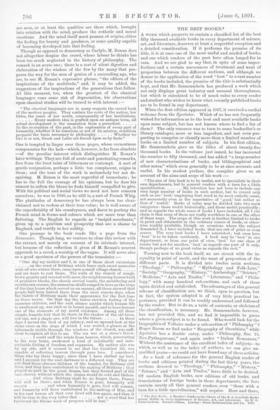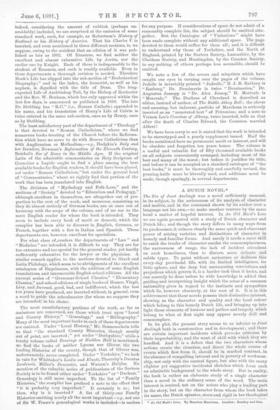THE BEST BOOKS.*
A WORK which purports to contain a classified list of the best
fifty thousand available books in every department of science, art, and literature, deserves at least a respectful reception and a detailed consideration. If it performs the promise of its title, it is at once one of the most useful and needed of books,
and one which readers of the past have often longed for in vain. And we are glad to say that, in spite of some imper- fections and a certain unevenness of treatment and want of proportion between the different sections, and although we demur to the application of the word "best" to a vast number of the books included, the promise of the title is substantially kept, and that Mr. Sonnenschein has produced a work which
not only displays great industry and unusual thoroughness, but which is calculated to be of much value to every reader and student who wishes to know what recently published books are to be found in any department.
When the first edition. appeared in 1887, it received a cordial welcome from the Spectator. Which of us has not frequently wished for information as to the best and most available books upon some subject, but has not known where to find a list of them P The only resource was to turn to some bookseller's or library catalogue, more or less imperfect, and not even pur- porting to comprise or classify more than a limited number of books on a limited number of subjects. In his first edition,
Mr. Sonnenschein gave us the titles of about twenty-five thousand books. In the volume just issued, he has increased the number to fifty thousand, and has added "a large number of new characterisations of books, and bibliographical and other notes," which seem generally to be at once accurate and useful. In his modest preface, the compiler gives us an account of the aims and scope of his work :—
" The aim of this book is to be useful, not to specialists in their own departments, but to general readers with a turn for a little specialisation My intention has not been to include any very large number of books in each section, but to record only such as are best,' employing that word in its most catholic sense, not necessarily even as the superlative of good,' but rather as that of 'useful.' Books of value may be divided into two main categories : those useful historically, and those useful practically ; and as regards the whole mass of books I have included, all I can claim is that none of thorn are really worthless in one or the other of these ways, The scope of this work is further limited to books in print and obtainable in the ordinary course of trade, or other- wise readily available, though on occasions where the subject demanded it, I have included books that are out of print or even scarce. The very best books I have asterisked ; but even here 'best' is to be taken cautiously. A book may be best' in one department, or from one point of view, 'best' for one class of reader but not fer another, 'beet' as regards one part of it only, though perhaps of no groat value as regards the rest."
Turning now to the book itself, we are struck with the in- equality in point of merit, and the want of proportion of the different parts. It is divided into twelve main sections, "Theology," "Philosophy," "Mythology and Folk-Lore," "Society," "Geography," "History," "Archeology," "Science," "Medicine," "Arts and Trades," "Literature," and "Philo- logy," with many hundred sub-sections, and each of these
again divided and subdivided. The advantages of this general scheme of classification are, we think, open to question, but in fact, the system adopted is of very little practical im- portance, provided it can be readily understood and followed by the reader. But to do so, a table of contents, or skeleton of
the classification, is necessary. Mr. Sonnenschein, however, has not provided this, and we find it impossible to guess where a given subject is to he found. Who would look for the biographies of Voltaire under a sub-section of " Philosophy " ? Roger Bacon we find under "Biography of Occultists," while Apaleius has a double entry, under "Philosophy, Sec. 15, Neo-Pythagoreans," and again under "Italian Romances."
Without the assistance of the excellent index of subjects—to which, as well as to the index of authors, we can give un- qualified praise—we could not have found any of these articles.
As a book of reference for the general English reader of books and editions printed during the last thirty years, the sections devoted to "Theology," "Philosophy," "History," "Science," and "Arts and Trades," leave little to be desired. Of modern English books, new editions of old books, and
translations of foreign books in these departments, the lists contain nearly all that general readers, even "those with a turn for a little specialisation," will require. Here and there, * The Beak Books, A Reader's Guido to the Choice of the B1 et Available Books (about 50,000) in every department of Selene°, Art, and Literatet- y W. S. Eonnensohein, second edition, London Swan Sonhensehein and Co. 1::1.
indeed, considering the amount of rubbish (perhaps un- avoidably) included, we are surprised at the omission of some standard work, snob, for example, as Robertson's History of Scotland or his History of America. That his Charles V. is inserted, and even mentioned in three different sections, is, we suppose, owing to the accident that an edition of it was pub- lished as late as 1882. Of Erasmus, we find neither the excellent and almost exhaustive Life by Jortin, nor the earlier one by Knight. Each of these is indispensable to the student of Erasmus, and each is readily available. Even in these departments a thorough revision is needed. Theodore Hook's Life has slipped into the sub-section of "Ecclesiastical Biography;" and in the index, the humorist, as well as his nephew, is dignified with the title of Dean. The long- expected Life of Archbishop Tait, by the Bishop of Rochester and. the Rev. W. Benham, which has only appeared within the last few days, is announced as published in 1888. The late Dr. Stebbing has ".RC." (i.e., Roman Catholic) appended to his name, and his translation of Henry's Life of Calvin is twice entered in the same sub-section, once as by Henry, once as by &ebbing.
The least satisfactory part of the department of "Theology" is that devoted to "Roman Catholicism," where we find numerous books treating of the Church before the Reforma- tion which have no more to do with Roman Catholicism than with Anglicanism or Methodism,—e.g., Hodgkin's Italy and her Invaders, Newman's Reformation of the Eleventh Century, Reichel's See of Rome in the Middle Ages. If the original Latin of the admirable commentaries on Holy Scripture of Cornelius a Lapide ought to find a place among the best available books for English readers, it should have been placed, not under "Roman Catholicism," but under the general head of "Commentaries," where we rightly find that portion of the work that has been translated into English.
The divisions of "Mythology and Folk-Lore," and the sections of " Society " devoted to "Education and Pedagogy," although excellent in themselves, are altogether out of pro- portion to the rest of the work, and moreover, consisting as they do almost entirely of German books, are at once out of harmony with the scope of the volume, and of no use to the mere English reader for whom the book is intended. They seem to include every book of merit or demerit, which the compiler has been able to discover in English, German, or French, together with a few in Italian and Spanish. These departments are, however, excellent for specialists.
For what class of ,readers the departments of " Law " and " Medicine " are intended, it is difficult to say. They are far too extensive and too special for the general reader, yet hardly sufficiently exhaustive for the lawyer or the physician. A similar remark applies to the sections devoted to Greek and Latin Philology, which seem to be abridgments of the excellent catalogues of Engelmann, with the addition of some English translations, and innumerable English school editions. All the current series of "Grammar-School Classics," "Elementary Classics," and school editions of single books of Homer, Virgil, Livy, and Juvenal, good, bad, and indifferent, which the last ten years have produced, are inserted without, in general, even a word to guide the schoolmaster (for whom we suppose they are intended) in his choice.
The most unsatisfactory portions of the work, as far as omissions are concerned, are those which treat upon "Local and County History," "Genealogy," and "Bibliography." Many of the most important books in each of these departments are omitted. Under "Local History," Mr. Sonnenschein tells us that "the standard County Histories, though mostly out of print, are inserted ;" yet under "Derbyshire," while a trashy volume called Evenings at Haddon Hall is mentioned, we find the books of neither Lysons nor Glover, the two leading Histories of the county, though that of Glover was, unfortunately, never completed. Under "Yorkshire," we look in vain for Whittaker's Loidis and Elmete, Thoresby's Ducatus Leodensis, Miller's Doncaster, and Watson's Hatifafe. No mention of the valuable series of publications of the Surteee Society is to be found either under" Yorkshire" or "Durham." Genealogy is still more imperfect. To the list of "Family Histories," the compiler has prefixed a note to the effect that "it is probably very imperfect." It certainly is so ; but then, why is it inserted P A list of thirty-one Family Histories omitting nearly all the most important—e.g., not one of Sir W. Fraser's genealogical works is included—is useless for any purpose. If considerations of space do not admit of a reasonably complete list, the subject should be omitted alto- gether. But the Catalogue of "Visitations" might have been made complete without any additional space. The page devoted to them would suffice for them all; and it is difficult to understand why those of Yorkshire, and the North of England, printed by the Surtees Society, Lancashire, by the Ohetham Society, and Huntingdon, by the Camden Society, to say nothing of others perhaps less accessible, should be omitted.
We note a few of the errors and misprints which have caught our eyes in turning over the pages of the volume. Jodelle is invariably printed " Jodrelle," E. J. B. Rathery is " Ratberg," Dr. Dezeimeris is twice " Dezeimeries," Dr. Augustus Jessopp is "Dr. Alex. jessop," H. Merivale is " Merevale." The Duchess of Cleveland is described as editor, instead of author, of The Battle Abbey Roll; the clever and amusing, but indecent, pastiche of Marchena is seriously inserted as an "annotated text" of Petronius ; and a note to Vernon Lee's Countess of Albany, twice inserted, tells us that after the death of Charles Edward, the Countess married Alfieri I We have been sorry to see it stated that the work is intended to be stereotyped and a yearly supplement issued. Half the books mentioned have no permanent merit or interest, and will be obsolete and forgotten ten years hence. The volume is a useful and valuable list of fifty thousand available books on all subjects conveniently arranged, including most of the beat and many of the worst; but before it justifies its title, and before it can be accepted as a standard catalogue of "the best books," it must be thoroughly and carefully revised, the pruning-knife must be liberally used, and additions must be made, though sparingly, in several departments.







































 Previous page
Previous page